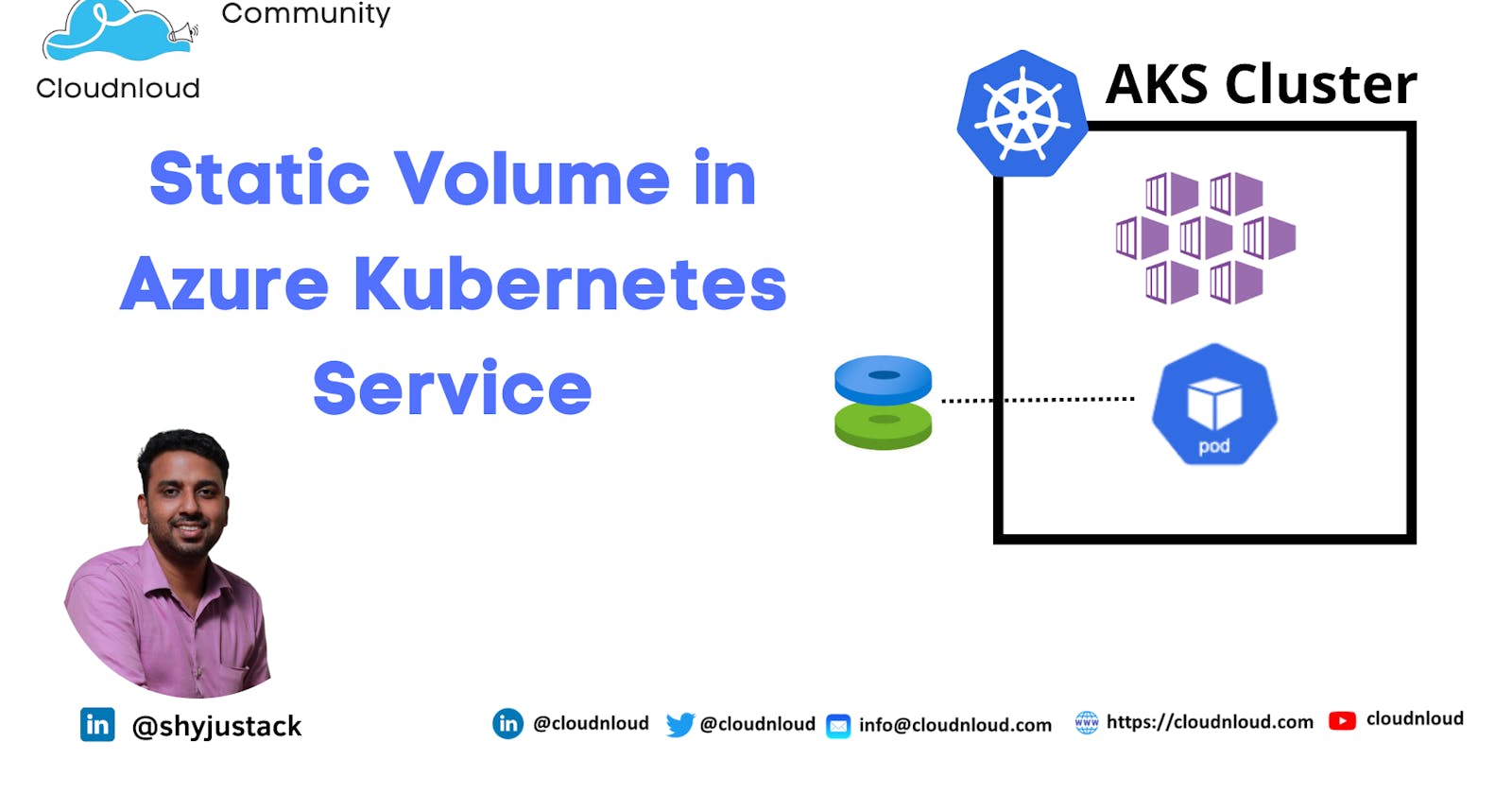Create a static volume with Azure disks in Azure Kubernetes Service (AKS)
This article shows you how to manually create an Azure disk and attach it to a pod in Kubernetes
Note: An Azure disk can only be mounted to a single pod at a time. If you need to share a persistent volume across multiple pods, use Azure Files.
Create an Azure disk
When you create an Azure disk for AKS, create the disk resource in the node resource group. This will allows the AKS cluster to access and manage the disk resource
In this article creating the disk group in the same resource group
First, Identify the resource group name using the az aks show command
az aks show --resource-group <ResourceGroup Name> --name <AKSCluster Name> --query nodeResourceGroup -o tsv
Example
shyju [ ~ ]$ az aks show --resource-group MYAKS --name MYCLUSTER --query nodeResourceGroup -o tsv
MC_MYAKS_MYCLUSTER_eastus #Resource group name
Create a disk using the az disk create command. Specify the node resource group name
az disk create \
--resource-group <resource group name>\
--name myAKSDisk \
--size-gb 10 \
--query id --output tsv
Example
shyju [ ~ ]$ az disk create --resource-group MC_MYAKS_MYCLUSTER_eastus --name myAKSDisk --size-gb 10 --query id --output tsv
/subscriptions/19a0ff5b-030e-48d7-84f0-fdbb3098b3f4/resourceGroups/MC_MYAKS_MYCLUSTER_eastus/providers/Microsoft.Compute/disks/myAKSDisk
shyju [ ~ ]$
The disk resource ID is displayed once the command has successfully completed, as shown in the following example output. This disk ID is used to mount the disk in the next section.
/subscriptions/<subscriptionID>/resourceGroups/MC_myAKSCluster_myAKSCluster_eastus/providers/Microsoft.Compute/disks/myAKSDisk
Mount disk as a volume
Create a PersistentVolume
apiVersion: v1
kind: PersistentVolume
metadata:
name: pv-azuredisk
spec:
capacity:
storage: 10Gi
accessModes:
- ReadWriteOnce
persistentVolumeReclaimPolicy: Retain
storageClassName: managed-csi
csi:
driver: disk.csi.azure.com
readOnly: false
volumeHandle: /subscriptions/<subscriptionID>/resourceGroups/MC_myAKSCluster_myAKSCluster_eastus/providers/Microsoft.Compute/disks/myAKSDisk
volumeAttributes:
fsType: ext4
Output
shyju [ ~ ]$ kubectl create -f pv.yaml
persistentvolume/pv-azuredisk created
PV Status
Kubectl get pv
Output
shyju [ ~ ]$ kubectl get pv
NAME CAPACITY ACCESS MODES RECLAIM POLICY STATUS CLAIM STORAGECLASS REASON AGE
pv-azuredisk 10Gi RWO Retain Available managed-csi 5s
shyju [ ~ ]$
Create a PersistentVolumeClaim that uses the PersistentVolume.
apiVersion: v1
kind: PersistentVolumeClaim
metadata:
name: pvc-azuredisk
spec:
accessModes:
- ReadWriteOnce
resources:
requests:
storage: 10Gi
volumeName: pv-azuredisk
storageClassName: managed-csi
shyju [ ~ ]$ kubectl create -f pvc.yaml
persistentvolumeclaim/pvc-azuredisk created
Output
shyju [ ~ ]$ kubectl get pvc
NAME STATUS VOLUME CAPACITY ACCESS MODES STORAGECLASS AGE
pvc-azuredisk Bound pv-azuredisk 10Gi RWO managed-csi 34s
shyju [ ~ ]$
Check the CSI drivers
shyju [ ~ ]$ kubectl get sc
NAME PROVISIONER RECLAIMPOLICY VOLUMEBINDINGMODE ALLOWVOLUMEEXPANSION AGE
azurefile file.csi.azure.com Delete Immediate true 18m
azurefile-csi file.csi.azure.com Delete Immediate true 18m
azurefile-csi-premium file.csi.azure.com Delete Immediate true 18m
azurefile-premium file.csi.azure.com Delete Immediate true 18m
default (default) disk.csi.azure.com Delete WaitForFirstConsumer true 18m
managed disk.csi.azure.com Delete WaitForFirstConsumer true 18m
managed-csi disk.csi.azure.com Delete WaitForFirstConsumer true 18m
managed-csi-premium disk.csi.azure.com Delete WaitForFirstConsumer true 18m
managed-premium disk.csi.azure.com Delete WaitForFirstConsumer true 18m
shyju [ ~ ]$
Create a POD reference for your PersistentVolumeClaim
apiVersion: v1
kind: Pod
metadata:
name: mypod
spec:
nodeSelector:
kubernetes.io/os: linux
containers:
- image: httpd
name: mypod
resources:
requests:
cpu: 100m
memory: 128Mi
limits:
cpu: 250m
memory: 256Mi
volumeMounts:
- name: azure
mountPath: /mnt/azure
volumes:
- name: azure
persistentVolumeClaim:
claimName: pvc-azuredisk
Creating the pod
shyju [ ~ ]$ kubectl create -f pod.yaml
pod/mypod created
Output
shyju [ ~ ]$ kubectl get pod
NAME READY STATUS RESTARTS AGE
mypod 1/1 Running 0 20s
Verify the disk status in the pod
shyju [ ~ ]$ kubectl exec mypod -- df -h
Filesystem Size Used Available Use% Mounted on
overlay 123.9G 23.2G 100.7G 19% /
tmpfs 64.0M 0 64.0M 0% /dev
tmpfs 3.4G 0 3.4G 0% /sys/fs/cgroup
/dev/sdc 9.9G 24.0K 9.8G 0% /mnt/azure
/dev/sda1 123.9G 23.2G 100.7G 19% /etc/hosts
/dev/sda1 123.9G 23.2G 100.7G 19% /dev/termination-log
/dev/sda1 123.9G 23.2G 100.7G 19% /etc/hostname
/dev/sda1 123.9G 23.2G 100.7G 19% /etc/resolv.conf
shm 64.0M 0 64.0M 0% /dev/shm
tmpfs 256.0M 12.0K 256.0M 0% /run/secrets/kubernetes.io/serviceaccount
tmpfs 3.4G 0 3.4G 0% /proc/acpi
tmpfs 64.0M 0 64.0M 0% /proc/kcore
tmpfs 64.0M 0 64.0M 0% /proc/keys
tmpfs 64.0M 0 64.0M 0% /proc/timer_list
tmpfs 64.0M 0 64.0M 0% /proc/sched_debug
tmpfs 3.4G 0 3.4G 0% /proc/scsi
tmpfs 3.4G 0 3.4G 0% /sys/firmware
Hope you got an idea of how to map the disk in POD inside the AKS Cluster Thank you!
Related/References
docs.microsoft.com/en-us/azure/aks/azure-di..

